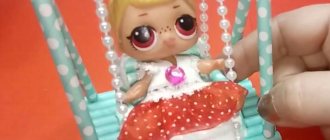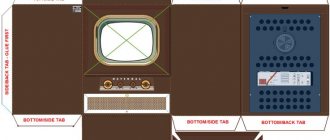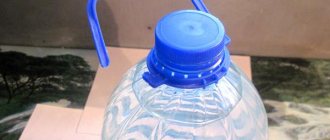A clamp is a very useful thing that will come in handy not only at the dacha during the summer season or in a private house, but also in the garage.
The most popular clamps are devices for clamping wire clamps.
They have found wide application in the household: both in the garden and at home. And making them with your own hands is not difficult. No special parts are required.
In this article we will share one of the simplest options for a “wire” clamp. We will make the device from scraps of metal - from what is at hand.
In addition, there are also clamps for tape clamps, which are used for high-quality clamping of CV joint boots on a car, and clamps for plastic ties. We will also tell you how to make them.
To make a clamp with your own hands, you can use used materials that everyone can find in their garage or home workshop.
Therefore, the cost of these devices is very low, and they require little time to manufacture.
Let's now look at 3 types of homemade tools: for wire and tape clamps, as well as for plastic ties.
Do-it-yourself clamp for tape clamps
The final stage of CV joint maintenance or replacement is the installation of a band clamp on the rubber boot. The problem is that it is impossible to tighten it by hand with sufficient force. As a result, many people simply buy worm-drive clamps for screwdrivers separately and throw away the standard ones. If you make a clamp of this design, you will be able to tighten the band clamps very securely and quickly.
Power clamps.
These are high-strength clamps designed for use in aggressive environmental conditions: strong vibration, temperature and pressure changes, high humidity. They are resistant to corrosion and strong mechanical stress. Produced in accordance with GOST 28191 and DIN 3017.
When using them, the tightening pressure is evenly distributed throughout the clamp, which guarantees the strength of the fixation. And the high breaking moment makes it possible to resist strong mechanical loads.
Produced in different diameters (from 19 to 140 mm) from:
- of stainless steel
- galvanized steel
- brass
Power single-bolt clamps for the intake system.
Clamp manufacturing process
To make a clamp, you will need a section of profile pipe 12-15 cm long. A hole with a diameter of 8 mm is drilled in it 5 cm from the edge.
Now you need to cut the bolt to screw on the clamp. When using a 15x15 mm profile pipe, it is enough to leave on it a piece of rod with or without thread 20 mm long (excluding the head). Then it needs to be sawn lengthwise. The slot must be thin, so it should be made with a 1 mm disk or a hand hacksaw for metal.
Now you should cut off the walls of the tubes from the side of the hole, as done in the photo. The remaining burrs from the grinder are removed.
To use the clamp, you need to install the clamp and manually tighten it. Next, you should insert its edge into the slot of the bolt inserted into the hole in the clamp.
Holding the device with one hand, you need to rotate the bolt with a key or head, thereby winding the tape onto it.
The tape will bend and everything will hold together.
Then the bolt is removed and the clamp tube is removed.
Homemade clamp for plastic ties
To make this homemade clamp, you will need a hex head bolt. It is necessary to make a longitudinal cut in the body of the bolt using a grinder.
We weld a piece of round steel rod to the bolt head. Screw the nut onto the bolt.
The author makes the second part of the clamp from a metal strip. You can see what this part looks like in the photo below.
Making such a thing is very simple. We cut off a piece of the strip, make cuts with a grinder and bend the edges on both sides in different directions. We leave a persistent “finger” on one side.
A simple tool for tightening automotive strap clamps
Greetings to everyone who loves to make things and learn new things. Today we propose to get acquainted with an interesting device offered by the author of the TEXaS TV channel, namely, a device for tightening tape clamps.
Band clamps are usually used as clamps for the CV joint boot, steering rack boot, and also for tightening various automotive pipes.
The device in question is designed to facilitate and simplify the tightening procedure, as well as ensure a more reliable fit of the clamps. This homemade product can be useful to all car enthusiasts who repair their iron “horses” on their own.
To create this device, the author needed:
1) A piece of metal (metal 2.5 mm thick is used here); 2) Two nuts (in this case the author uses 8 nuts, with a 13 wrench). 3) Old stabilizer link. 4) Bulgarian. 5) Drill.
According to the author, it will take approximately 1 hour to create this device.
So, here's what you need to do with all the above parts to get a useful and convenient device for tightening car clamps.
A strip 23 mm wide is cut out of metal. However, the dimensions of length and width are not of great importance here; they were chosen arbitrarily by the author. Accordingly, you can make such a strip larger or smaller - the main thing is that the device is convenient to use later. Next, a wedge-shaped narrowing is made at one end of the strip. A metal ring is welded to the other end - for ease of storage - from the stabilizer strut.
At the next stage, two nuts are welded to the strip - at the place where it begins to narrow - through the internal holes of which the rod will subsequently have to pass.
Therefore, if these holes are smaller than the diameter of the rod, as happened when the author created the idea, they will have to be expanded to a suitable size.
We take the old stabilizer link and now cut off such a fragment from it with a rod length of 35 mm.
Carefully make a through cut in the rod using a grinder (we will tuck the tip of the clamp into it).
Insert the rod into the holes of the nuts.
On this, in fact, the creation of a homemade product is completed. Our clamp tightening device is ready to use.
It works very simply. We put the clamp on the part that needs to be equipped with a boot.
Then we put on the boot itself, making sure that it fits into its seat.
After this, we put the clamp on the boot and first tighten it by hand as much as possible.
And now it’s our turn to adapt. We attach it to the clamp and thread the tip of the clamp into the cut of the rod.
Now all that remains is to turn the rod a few times, and the clamp will tighten without much effort.
After we have clamped the clamp, we turn its tip up, secure it and cut off the unnecessary length.
By the way, this homemade product is easily simplified. So, if you do not have welding skills or simply do not have a welding machine at hand, as well as an unnecessary stabilizer bar, this is not a problem at all.
CV joint clamps.
These are special automotive clamps designed for attaching the CV joint boot. It is used to create a tight seal on the CV joint, prevent dust, dirt and water from getting under the boot and prevent lubricant leakage. This clamp is made in the form of a tape with holes into which the protrusion is threaded, fixing the clamp.
Types of CV joint clamps:
- Universal: tape width 7/8/9 mm and diameter from 21 to 190 mm.
- Individual: for certain car models.
CV joint clamps.
Homemade pliers for CV joint clamps. (Oetiker stainless steel clamps)
R.Petrovich
Master Advisor
I made a device for mounting clamps; I think this tool can handle even the toughest stainless steel clamps. Anyone who has a welding machine and an angle grinder can make such a device. The main working parts are made of two cutters, I don’t understand cutters, I found cutters made of some strong alloy on the market, they are without soldering, a file does not take them, the cross-section of the cutters is 10*10mm. The cutters are probably hardened and fragile, to be on the safe side, I released them on the gas stove; after the release, the file began to leave faint marks. I formed the working parts in the cutter with a grinder with a small thin circle, the metal is quite hard and reluctant to give in. After the cutouts were ready, I connected the halves and fastened them with several welding points, and in the connected state I ground down the working parts to a thickness of about 1.5 mm. It was decided to weld the cutters into the handles of the pliers; I just happened to have some unclaimed pliers lying around, and this was the result.
The jaws will be tightened with an M10 bolt through a long nut; the nut is welded onto two plates. You can take a regular bolt; due to the long nut, the load on the thread is small, but a ball with a diameter of about 6 mm must be installed in the end of the bolt to minimize the friction of the bolt on the cutter. Here's a photo of what happened
Included with the GKN plastic boots are Oetiker clamps with a section of 10*0.8 small and 10*1mm large, for which the tightening torque is 5000N and 7000N, respectively.
Let's calculate the twisting force, the lever can be neglected, and the friction of the ball on the cutter.
Мр is the torque required to create an axial force on the bolt. Мр=0.5*F0*dср*tg(xi+po) xi=atg(P/(Pi*dср)) FO - axial force of the bolt dср - average thread diameter. xi is the thread lifting angle. P - thread pitch ro - friction angle of the threaded pair po=atg(fp), fp=0.15 - friction coefficient of ungreased bolt-nut
Source
Spring clamps.
This type is used on objects undergoing linear expansion, when, due to temperature fluctuations, the system contracts and expands. Withstands temperature fluctuations from -40 to +200 degrees Celsius.
The simple design of such a clamp: a solid spring steel strip with two curved ends for hooking. However, they provide very strong fixation and sealing of hoses and pipes. It is very simple to secure such a clamp: you need to bring the bent ends together using pliers, put it on the hose and release it. The steel will spring back and take on the required diameter. A large range of diameters (10 – 60 mm) will allow you to choose the one you need.
Spring clamps.
Making a clamp
First, you need to remove the latch itself from the body.
The recesses for the latch handle had to be slightly bored to fit the diameter of the latch. I made such a crank from a latch. I cut a longitudinal groove on top of the body (along which the latch handle moved) right through; before doing this, the mounting holes in the body must be welded or riveted, otherwise the body will fall apart.
One end of the body needs to be lightly ground onto a wedge from the planes below and above.
The second end was ground onto the wedge from the sides. In the middle of the resulting wedge, I sawed a small groove along the plane. The device is ready for use. Cleaned with a cord brush.
I decided to write a short article about the clamps that secure the CV joint boots in place. Since the ATV is used in mud, it is very important to monitor the condition of the anthers themselves, and of course, to ensure that they are securely fixed and prevent swamp-clay slurry from getting into the assembly.
I came across three suitable clamps, two of them came with anthers, the third I just bought in a store for comparison. And of course, each clamp has its own tool for work.
The most convenient and reliable clamp is the standard one. Firstly, it fastens as tightly as possible, and secondly, it is reusable, and if it is not specially broken in some way, it can withstand many removals and installations.
How to make a clamp: 3 different designs
A clamp is a very useful thing that will come in handy not only at the dacha during the summer season or in a private house, but also in the garage.
The most popular clamps are devices for clamping wire clamps.
They have found wide application in the household: both in the garden and at home. And making them with your own hands is not difficult. No special parts are required.
In this article we will share one of the simplest options for a “wire” clamp. We will make the device from scraps of metal - from what is at hand.
In addition, there are also clamps for tape clamps, which are used for high-quality clamping of CV joint boots on a car, and clamps for plastic ties. We will also tell you how to make them.
To make a clamp with your own hands, you can use used materials that everyone can find in their garage or home workshop.
Therefore, the cost of these devices is very low, and they require little time to manufacture.
Let's now look at 3 types of homemade tools: for wire and tape clamps, as well as for plastic ties.
How to tighten the CV joint boot clamp? 3 ways
Some newbie car enthusiasts are interested in the question: how to tighten the CV joint boot clamp yourself so that it holds securely? Options arise: is it possible to use plastic clamps instead of metal clamps? They find out, can this be done with wire? Are you wondering if it is possible to install helical clamps on CV joint boots? Immediately about plastic: plastic can be soft or fragile, in general - not reliable! To be honest, in practice I have never seen these spare parts or the drive fitted with plastic clamps. Regarding the wire:
this action is the invention of the wooden bicycle, in my opinion.
This method can only be used for a temporary delay. But in the nature of car enthusiasts, as we know: there is nothing more permanent than temporary. In addition, choosing the appropriate wire so that it does not cut the boot itself and is not too soft at the same time is a rather savvy task. And when using helical (worm-shaped) clamps, there is a high probability of the screw itself unwinding or clinging to something while driving. How to tighten the CV joint boot clamp?
So, we use special clamps designed for these purposes. They come in two types. The first one is with a U-shaped lock. The second is of the tape type. Both types, as a rule, are made (even handicraft, “cooperative” production) from fairly correctly selected alloys. That is, they provide both sufficient rigidity during operation and the possibility of plastic deformation during the tightening process. In addition, both types are universal. There are only two main sizes, allowing you to fix anthers from 18 to 110 mm. in diameter. Let's take a closer look at how to use both options.
Band clamp (manual method)
The tape is quite easy to install on the boot using simple improvised means. Let's use pliers. So: we put on the clamp, pull the tip with maximum force with pliers, and bend it up. By bending the special antennae located on the clamp ring, we fix the end of the tape. We cut off the excess tape (bite it off with tongs or wire cutters - whatever you have at hand). Probably everyone can do this procedure, even a beginner.
Plastic and wire clamps
Plastic clamps are not used to secure the boot. This is due to low strength and reliability of fastening. Such a clamp is not able to withstand dynamic loads, and is also prone to damage from high and low temperatures.
A correctly installed wire clamp does not differ in fixation strength from the factory one. Despite this, its use is not recommended for the following reasons:
- too much tightening leads to cutting the boot;
- the wire may not be rigid enough, which will lead to loosening of the fastening;
- lack of strength causes the wire to break during operation.
Unlike plastic, a homemade wire clamp can serve as a temporary replacement for the original. At the first opportunity, you should replace this mount with a more reliable one.
Clamp fastener
Some European-made cars have switched to using clamp clamps, as they combine reliability and simplicity. To install them, special pliers for CV joint clamps are used.
Placing the clamp on the CV joint occurs in the following order:
- The required diameter is selected;
- The clamp is located on the boot. It should be installed without distortions;
- To perform crimping, clamp pliers are used. If they are unavailable, you can use pliers of a suitable size;
- Upon completion of work, you should check the reliability of fixation of the clamp.
The main advantage of clamping fasteners is that there is no need to purchase expensive special tools. Carrying out the work with conventional pliers will ensure high reliability and long service life.
Alternative options
You can also secure the CV joint boot clamp using a screw clamp. You can use a wrench or a screwdriver to tighten it. It practically does not require any skills to fix it, but it has a number of disadvantages that do not allow it to occupy the niche of clamps for CV joints:
- the grenade is susceptible to parasitic vibrations, which causes the bolt to unwind, especially if the clamp is installed without sufficient tightening;
- the design feature in the form of a protruding lock is capable of clinging during operation;
- frequent cases of loose fixation due to poor quality of clamps.
A temporary alternative placed on the CV joint can be a screw clamp with a key. Its installation can be done on the road to ensure that the lubricant is not contaminated when traveling to a service station.
When choosing between a band clamp and a clamp clamp, you should be guided by your preferences and the manufacturer’s recommendations. They both can last a long time if installed correctly. Care and accuracy when installing any of the fasteners will allow the lubricant to remain clean for a long time.
CV joint boot clamp, pliers, pliers and other devices and tools for installation, crimping and tightening of tape and plastic types
If you have any questions, leave them in the comments below the article. We or our visitors will be happy to answer them
Using special devices when installing a band clamp
To simplify tightening the tape and improve the quality of fixation of the boot, a special tightening machine is used. Its design includes:
To use the device, you should follow the plan:
- Place the tape over the boot;
- Insert its end into the cut of the holder;
- Place the holder against the clamp lock;
- Using rotational movements, begin to wind the tape onto the tool;
- With sufficient tension, bend the tape;
- Check the fastened clamp for correct installation.
To ensure high-quality installation, the final force must be correctly determined. The tightening force should not allow the grease to come out, but it should not allow the boot to cut.
Worm Clamps:
These clamps have a special screw with a worm thread. The rotation of such a screw leads to tightening of the tape. The tape contains through or non-through, pressed, notches at a certain equal distance. The type of notch determines the strength of the clamp. Thus, clamps with through notches or pressed inwards are less durable, and when tightened they can damage the rubber of the hose. The most durable and effective worm-drive clamps are those with a smooth inner surface of the belt and pressed outward notches. The screw head is specially made with slots for a slotted and (or) Phillips screwdriver, which allows it to be used even in the most difficult to reach places. Worm gears are produced in accordance with GOST 28191 and DIN 3017.
An important nuance: when choosing a worm-drive clamp, pay attention that the lower band of the clamp is welded to the screw mechanism. Clamps with unwelded tape, if handled carelessly, may unexpectedly open up.
These clamps are made from:
- galvanized steel – used at low humidity.
- stainless steel – suitable for use in aggressive environmental conditions, high humidity (even under water).
Worm-worm clamps with notches pressed outwards.
2017-04-21
Pliers for CV joint clamps
Returning to the topic of replacing CV joint covers. Today's covers are tougher than the rubber ones of old. And it is almost difficult or impossible to tighten them normally with the usual tape clamps. Therefore, more modern clamps are used. They come in different types: with tricky locks, etc. But among inexpensive options, clamps with U-shaped “ears” are popular:
In my case it was exactly like that. And I decided to get some pliers to tighten them. In my case it is Licota ATC-2190:
Signs of boot failure
As mentioned in one of the previous sections, the boot has become something of a consumable item for car enthusiasts. If he “walks” for at least a year, this can already be called an excellent result. It is very easy to identify a defect in the boot - just inspect the boot properly. A sign of product failure is:
- Rupture in one or more places;
- The presence of grenade lubricant on the outer surface of the boot;
- The appearance of a large number of small cracks.
Although it is recommended to inspect the boot every 10-15 thousand kilometers (and even more often in the case of a cheap consumable), often the car owner receives a signal about the need to replace it without a visual inspection - when a grinding and crunching sound begins to be heard in the lower part of the car.
The master came up with a tool - a clamp for tightening tape clamps
Often, screw clamps are not suitable for repairs, for example for a car CV joint. To tighten tape clamps, the master created a device that in many cases turns out to be more practical, and sometimes even safer, than store-bought ones. Working with this tool is quick, and the advantage of its functions is savings, especially with large volumes of work. To work you need a short piece of metal strip, a bolt and a couple of nuts.
The master gave the workpiece the desired shape, slightly pointed at the end
Source
Design features of the product
A clamp is a simple and effective device that has a lot of standard variations, but, in essence, they all have similar design characteristics. The difference is presented in the form of shapes and fastening devices. Their use is most common in the field of installation and repair of pipeline systems; this determines another characteristic feature of the design. For better fixation and tightness, the product often has a rubber gasket.
Regarding the practical benefits of the products in question, we can say that without them it is almost impossible to carry out high-quality fixation of the pipeline, both horizontal and vertical.
The line of types of this device begins with the simplest one-sided products, which are a threaded pin. It then continues with variations that differ not only in the greater complexity of the design, but also in size (this should be understood as the maximum diameter of the pipe for which a particular product can be used) and intended purpose.
Clamps
The most common problems that clamps help solve:
- Repairing cracks in pipeline systems. Depending on the type of product, even fairly large damage can be covered.
- Pipe fracture is not a common but serious problem. For the most part, it is encountered by those who professionally install and repair pipelines.
- Also, if it is necessary to eliminate “fistulas” in water pipes, clamps are again widely used. In such a situation, it is necessary to use a soft substrate.
Note! If the pipe being repaired is used to transport corrosive liquids, then it is necessary to use a type of fastener that can withstand these specific operating conditions.
- Specifically for steel pipes, the product can help reduce the risk of leaks caused by corrosion. Situations often arise where it damages the metal so much that a leak can occur at any minute.
The market is saturated with all sorts of configurations of clamps from different manufacturers. Factory production, in addition to professional manufacturing, also provides a guarantee of quality. After all, the products are manufactured in accordance with GOST. Such government quality regulation is associated with the high degree of role of clamps in maintaining the integrity of the structures in which they are used. Based on this, the question arises whether it is worth making a clamp for a steel pipe with your own hands.
Question arises
What to do if the boot breaks on the road
It happens that when changing a wheel, a crack or break in the cover is discovered. In this case, you need to take some action to maintain the condition of the joint and protect yourself on the road. To do this, follow these steps:
- Place the vehicle on a jack;
- If possible, remove all the old grease and fill the boot with new grease until it stops;
- Wrap the entire cover with a plastic bag and tighten it at the recesses in the corrugation with a rope;
- It is advisable to go over the top with insulating tape or regular tape.
This solution will allow you to travel about 500 km without any problems. However, it is recommended to periodically check the integrity of the boot to avoid problems with the hinge. If the vehicle is driven on a dirt road or during rainy weather, it is best to visit the nearest service center and get the help of specialists.
If you don’t know how to replace the boot yourself, this video will give comprehensive answers on changing an integral element of the hinge and tips on repairing and maintaining the CV joint.
Alternatives
There is an opinion among car enthusiasts that standard CV joint clamps are unreliable. We will not find out the reasons for such notoriety; there can be many of them: from violation of production technology and savings on quality raw materials to incorrect installation. Let's consider which alternatives to standard clamps have become the most popular when securing CV joint boots.
The first and most obvious substitute is a screw clamp. The one that everyone is used to seeing on hoses. This element is tightened by screwing in the bolt. It looks like this:
In principle, this element should provide a sufficiently strong fixation and prevent dust or water from getting into the pad.
The second most popular substitute was plastic clamps (ties). According to reviews from car owners, clamps made of good plastic last a really long time. As for fixation, it is definitely not inferior to standard CV joint clamps. The problem here is to find a good plastic tie.
Why attach a clamp to a CV joint?
The CV joint is a reliable mechanism that can travel more than 150,000 km without problems, but over time it becomes unusable. An unpleasant crunch indicates problems with the part. Not only used cars, but also brand new cars can crunch. The ability of a hinge to serve faithfully for a long time depends on 2 conditions:
- complete lubrication;
- protection from negative environmental influences (pollution or water ingress).
The hinge needs to be lubricated - and the more often the better. And it is protected with the help of a boot, which is put on the shaft and reliably covers the elements of the assembly. The boot is secured with clamps. When they weaken, an unpleasant sound is heard. Therefore, from time to time the driver is faced with such a task as tightening the CV joint boot clamps.
There are several ways to attach a CV joint:
- belt mechanism;
- clamping fastener;
- U-shaped mounting option.
How to inspect the case
This can be done without removing the wheel: just turn it all the way in any direction and shine a flashlight on the part for better visibility. Also feel it with your hands: you will feel the tears immediately. The best inspection option is to remove the wheel (for example, when you are repairing a tube, a tire at a tire shop, or doing a seasonal tire change). Everything will be more noticeable here. Also, for one reason or another, you probably have to put the car in the inspection hole: for example, when changing the oil, adjusting the hand brake, etc. Here, also take the opportunity and inspect the CV joint covers: this can be done more carefully than in previous cases.
You can tell that the cover needs to be replaced by the appearance of thick grease on the suspension parts and on it itself.











